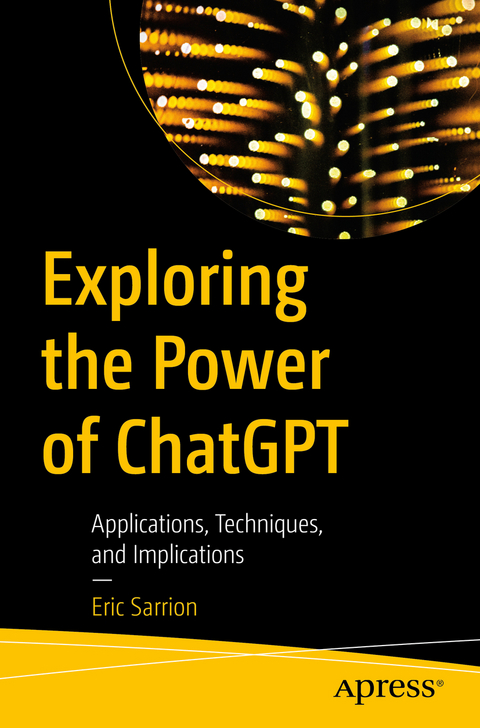
Exploring the power of ChatGPT
Apress (Verlag)
978-1-4842-9528-1 (ISBN)
Author Eric Sarrion examines various aspects of ChatGPT, including its internal workings, use in computer projects, and impact on employment and society. He also addresses long-term perspectives for ChatGPT, including possible future advancements, adoption challenges, and considerations for ethical and responsible use. The book starts with an introduction to ChatGPT covering its versions, application areas, how it works with neural networks, NLP, and its advantages and limitations. Next, you'll be introduced to applications and training development projects using ChatGPT, as well as best practices for it. You'll then explore the ethical implications of ChatGPT, such as potential biases and risks, regulations, and standards. This is followed by a discussion of future prospects for ChatGPT. The book concludes with practical use case examples, such as text content creation, software programming, and innovation and creativity.
This essential book summarizes what may be one of the most significant developments in artificial intelligence in recent history and provides useful insights for researchers, policymakers, and anyone interested in the future of technology.
What You Will Learn
Understand the basics of deep learning and text generation using language models such as ChatGPT
Prepare data and train a language model to generate text
Use ChatGPT for various applications such as marketing text generation or answering questions
Understand the use of ChatGPT through the OpenAI API and how to optimize model performance
Who This Book Is ForSoftware developers and professionals, researchers, students, and people interested in learning more about this field and the future of technology.
Eric Sarrion is a trainer, developer, and independent consultant. He has been involved in all kinds of IT projects over the past 30 years. He is also a long-time author of web development technologies and is renowned for the clarity of his explanations and examples. He resides in Paris, France.
Part 1: Introduction to ChatGPT1 - What is ChatGPT ?Describes hat is ChatGPT, its history...
•1.1 Definition of ChatGPT•1.2 ChatGPT History•1.3 Versions of ChatGPT•1.4 Application areas of ChatGPT
2 - How Does ChatGPT Work?Describes how it works inside
•2.1 Neural networks•2.2 Natural language processing techniques used by ChatGPT•2.3 The data used to train ChatGPT•2.4 The advantages and limitations of ChatGPT
3 - Applications of ChatGPTDescribes what you can do whith ChatGPT
•3.1 Chatbots and virtual assistants•3.2 Machine translation apps•3.3 Content writing apps•3.4 Applications in information retrieval
Part 2: How To Train and Use ChatGPT
4 - ChatGPT TrainingDescribes how to build the models used by ChatGPT
•4.1 Data collection and preparation•4.2 ChatGPT training settings•4.3 Training tools available•4.4 Techniques to improve ChatGPT performance
5 - Using ChatGPT in Development ProjectsDescribes how to use ChatGPT in a web page with an API
•5.1 Libraries and frameworks for ChatGPT•5.2 Examples of projects using ChatGPT•5.3 Techniques to integrate ChatGPT into applications•5.4 Use ChatGPT with the OpenAI API•5.5 Use ChatGPT with a voice interface•5.6 Methods to evaluate the performance of ChatGPT
6 - Best Practices for Using ChatGPTDescribes how to optimize ChatGPT
•6.1 Strategies to ensure the quality of input data•6.2 Techniques to avoid bias in data•6.3 Methods to optimize ChatGPT performance•6.4 ChatGPT maintenance tips
Part 3 The Ethical Implications of ChatGPT
7 - Potential Biases and Risks of ChatGPTDescribes biases and riks of ChatGPT
•7.1 Sources of bias in the data•7.2 The risks of discrimination and stigmatization•7.3 The limits of ChatGPT transparency•7.4 Consequences for privacy and data security 8 - The Implications of ChatGPT on Employment and SocietyDescribes impacts on employment and society
•8.1 The impacts on employment in various sectors•8.2 The implications for education and vocational training•8.3 Consequences for social and cultural norms•8.4 Political and legal responses to the changes brought about by ChatGPT
9 - Regulations and Standards for Using ChatGPTDescribes responsible use of ChatGPT
•9.1 Existing regulations for consumer protection•9.2 Standards for Responsible Use of ChatGPT•9.3 ChatGPT governance initiatives•9.4 Considerations for Legal and Ethical Responsibility of ChatGPT
Part 4 Future Prospects of ChatGPT
10 - Future Developments of ChatGPTDescribes future developments
•10.1 Advances in Machine Learning and Natural Language Processing Research•10.2 ChatGPT performance and efficiency improvements•10.3 Advances in applications and areas of use of ChatGPT•10.4 Developments in the competition and the ChatGPT market
11 - The Long Term Outlook for ChatGPTDescribes long term outlook
•11.1 The implications for artificial intelligence and cognition•11.2 Merging possibilities between ChatGPT and other emerging technologies•11.3 The challenges of adopting and accepting ChatGPT•11.4 Issues for regulation and governance of ChatGPT
Part 5 : Examples of Using ChatGPT
12 - Using ChatGPT for Text Content Creation
13 - Using ChatGPT for Software Programming
14 - Using ChatGPT for Text Translation
15 - Using ChatGPT for Artistic Content Creation
16 - Using ChatGPT for Innovation and Creativity
17 - ConclusionGives a conclusion of the book
•17.1 Summaries of the key elements covered in the book•17.2 Final thoughts on the impact and implications of ChatGPT•17.3 Suggestions for future research and development on ChatGPT•17.4 Considerations for the ethical and responsible use of ChatGPT in the future.•17.5 In conclusion
| Erscheinungsdatum | 15.08.2023 |
|---|---|
| Zusatzinfo | Illustrationen |
| Verlagsort | Berkley |
| Sprache | englisch |
| Maße | 155 x 235 mm |
| Gewicht | 338 g |
| Einbandart | kartoniert |
| Themenwelt | Informatik ► Theorie / Studium ► Künstliche Intelligenz / Robotik |
| ISBN-10 | 1-4842-9528-5 / 1484295285 |
| ISBN-13 | 978-1-4842-9528-1 / 9781484295281 |
| Zustand | Neuware |
| Haben Sie eine Frage zum Produkt? |
aus dem Bereich


